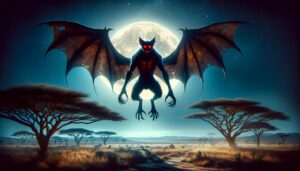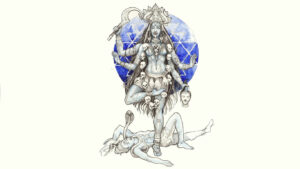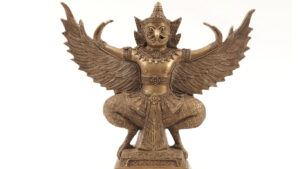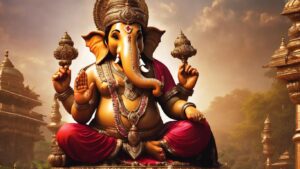Table of Contents
An Asura is a powerful and often malevolent supernatural being or demon in Hindu mythology, known for ambition, strength, and occasional opposition to the Devas, symbolizing the eternal struggle between order and chaos.
Who is Asura
An Asura, in Hindu mythology, is an influential and sometimes malevolent entity possessing notable strength, intellect, and ambition. As dynamic beings, Asuras play a pivotal role in the cosmic order, engaging in a perpetual struggle with the Devas, the celestial beings. This struggle epitomizes the ongoing battle between righteousness and unrighteousness, order and chaos.
Asuras are characterized by their ambitious pursuits, often driven by a desire for power, wealth, and even immortality. Some Asuras, however, are depicted as intellectuals, engaging in profound meditation and scholarly activities to enhance their understanding of the universe.
Their personalities exhibit a range of traits, from resilience and creativity to egoism and pride. Negative portrayals emphasize their egoistic tendencies, leading to conflicts with divine forces and challenges to established cosmic norms.
The diversity within the Asura category, as some are depicted with malevolent intentions, while others embody benevolence and virtue. This intricate portrayal reflects the rich tapestry of Hindu mythology, where Asuras contribute to the intricate balance of cosmic forces.
Physical Description
Asuras in Hindu mythology are portrayed with diverse physical attributes, reflecting their dynamic nature as powerful and multifaceted beings. While specific details can vary across myths and stories, general physical descriptions of Asuras may include:
Majestic Appearance: Asuras are often described as majestic beings, displaying a regal and imposing presence that reflects their strength and prominence.
Elaborate Attire: They are frequently depicted wearing elaborate clothing and adorned with jewelry, emphasizing their status as powerful and regal entities.
Multiple Heads or Arms: Some Asuras are described with multiple heads or arms, symbolizing their extraordinary strength and supernatural capabilities.
Monstrous Features: In certain negative portrayals, Asuras may take on monstrous forms, featuring fearsome and intimidating characteristics, such as menacing facial features, tusks, or horns.
Animalistic Traits: Asuras may be associated with animalistic traits, further highlighting their connection to the natural world. This can include features like tusks, horns, or other elements reminiscent of animals.
Varied Forms: The appearance of Asuras can vary widely, reflecting their diverse personalities and roles in different myths. Positive Asuras may be depicted with more benevolent and aesthetically pleasing attributes.
Personality

Asuras in Hindu mythology exhibit a diverse range of personalities. They embody ambition, intelligence, and resilience, often engaging in a perpetual struggle with the Devas, representing the eternal conflict between order and chaos. Their ambitious pursuits, driven by a thirst for power and wealth, can lead to confrontations and challenges to established cosmic norms.
Negative portrayals emphasize egoistic tendencies, showcasing their pride and arrogance, which frequently result in conflicts with divine forces. However, some Asuras are depicted as intellectuals, delving into meditation and scholarly pursuits to deepen their understanding of the universe.
Their personalities encompass a spectrum of traits, from creative and virtuous to malevolent and egocentric. This nuanced portrayal underscores the intricate balance of cosmic forces within Hindu mythology, where Asuras play a pivotal role in shaping the dynamics of the celestial order.
Andhaka
Andhaka is a notable Asura in Hindu mythology, known for his complex and intriguing story. Here are key aspects of Andhaka’s character and narrative:
Origin: Andhaka’s origin story varies across different Hindu texts. One common version suggests that he was created from the sweat of Lord Shiva when he engaged in intense penance.
Adoption by Parvati and Shiva: Andhaka was adopted by Parvati and Shiva after being found in a pit. However, due to a misunderstanding, he grew up thinking that Parvati was his mother and Shiva his father.
Love for Parvati: As Andhaka reached adolescence, he developed romantic feelings for Parvati. When his advances were rejected, he persisted in pursuing her, leading to conflicts.
Curse and Transformation: Due to his relentless pursuit and a curse from Sage Bhringi, Andhaka was blinded. As a result, he came to be known as “Andhaka,” meaning “the blind one.”
Battle with Shiva: In some versions of the story, Andhaka, driven by his blindness and rage, engaged in a fierce battle with Shiva. Despite Shiva’s attempts to quell the conflict peacefully, Andhaka persisted in his aggression.
Redemption: Eventually, Andhaka’s eyes were opened to the truth of his origin, and he realized Shiva’s divine nature. Seeking redemption, he bowed to Shiva, who, acknowledging Andhaka’s transformation, forgave him and restored his vision.
Andhaka’s story is often interpreted as symbolic, representing the themes of desire, redemption, and the cyclical nature of existence in Hindu mythology. His tale illustrates the transformative power of divine realization and forgiveness.
Bhasmasura
Bhasmasura, an intriguing character in the Asura theme of Hindu mythology, emerges as a formidable demon with a complex narrative:
Penance and Boon: Bhasmasura’s tale begins with intense penance and devotion to Lord Shiva. In recognition of his dedication, Shiva grants him a potent boon, enabling him to turn any being into ashes by a mere touch on their head.
Deceptive Intentions: Fueled by arrogance and a desire to test the extent of his newfound power, Bhasmasura sets his sights on challenging the gods, showcasing the darker side of Asura ambition.
Targeting Shiva: In a twist of fate, Bhasmasura chooses Lord Shiva as his target, unaware that his actions would lead to a perilous confrontation with the divine.
Deception by Vishnu: Recognizing the imminent threat to the cosmic order, Lord Vishnu intervenes. Assuming the guise of the enchanting Mohini, Vishnu captivates Bhasmasura with a dance, leading him to mimic the moves.
Self-Destruction: Seizing the opportunity, Mohini tricks Bhasmasura into placing his hand on his own head, invoking the destructive power of the boon. The demon, unaware of the deception, meets his own demise, turning into ashes.
Bhasmasura’s story within the Asura theme serves as a cautionary tale about the consequences of unchecked ambition, the deceptive nature of power, and the divine forces’ ability to maintain cosmic balance.
Vritra
Vritra is a prominent figure in Hindu mythology, particularly within the Asura theme. Here are key aspects of Vritra’s character and narrative:
Asura of Drought: Vritra is often depicted as a powerful Asura associated with drought and the withholding of waters. His name, which means “enveloper” or “obstructor,” reflects his role in hindering the flow of rivers.
Confrontation with Indra: One of the most well-known stories involving Vritra is his conflict with the god Indra. Vritra, seizing control of the waters, challenges Indra, the king of the Devas, leading to a cosmic battle.
Formidable Serpent Form: Vritra is sometimes described as a formidable serpent or dragon, symbolizing chaos and obstruction. In this form, he coils around mountains, holding back the waters that sustain life.
Defeat and Liberation of Waters: The epic battle between Vritra and Indra reaches its climax when Indra, wielding the thunderbolt (Vajra), defeats the Asura. With Vritra’s demise, the waters are liberated, flowing freely once again to nurture the earth.
Symbolism: Vritra’s story carries symbolic significance, representing the cyclical nature of seasons and the struggle between order (Devas) and chaos (Asuras). The defeat of Vritra is celebrated as a victory for cosmic order and the renewal of life.
Vritra’s character within the Asura theme exemplifies the dynamic interplay between divine forces and cosmic elements in Hindu mythology, emphasizing the importance of balance and the cyclical nature of natural phenomena.
Cultural Representation
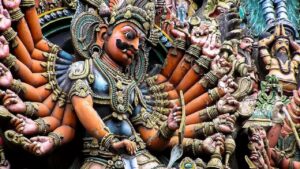
Vritra’s cultural representation extends beyond the confines of Hindu mythology, influencing art, literature, and philosophical discourse. Here are some aspects of Vritra’s cultural representation:
Art and Iconography: Vritra is often depicted in traditional Hindu art, especially in illustrations of the Rigvedic hymns describing his conflict with Indra. These artistic representations may emphasize his serpent-like form and the cosmic battle with the god of thunder, Indra.
Literary References: Vritra’s story is a recurring theme in Hindu literature, including the Rigveda and later Puranic texts. These narratives contribute to the rich tapestry of Hindu epics and philosophical discussions on the cosmic order and the forces of chaos.
Symbolism in Rituals: The defeat of Vritra by Indra is symbolic of the victory of order over chaos and the restoration of balance. This symbolism is often incorporated into Hindu rituals and festivals, serving as a cultural touchstone for themes of renewal and cosmic equilibrium.
Philosophical Interpretations: Vritra’s narrative has been subject to philosophical interpretations within Hinduism. The struggle between Vritra and Indra is sometimes seen as an allegory for the internal and external challenges faced by individuals on the path to self-realization and spiritual enlightenment.
Cultural Festivals: Stories involving Vritra are integrated into cultural festivals and celebrations, where the themes of victory over adversity and the restoration of natural order resonate with broader cultural values.
Modern Adaptations: Elements of Vritra’s story may find their way into modern adaptations, including literature, theater, and visual arts. Contemporary artists and writers may draw inspiration from Vritra’s character to explore themes of conflict, renewal, and cosmic balance.
In essence, Vritra’s cultural representation is deeply embedded in the broader cultural and philosophical tapestry of Hinduism, influencing various aspects of artistic expression, literature, rituals, and philosophical discourse.
Modern Appearances
In modern contexts, Vritra and related themes from Hindu mythology, including the conflict with Indra, find representation in various forms of media, literature, and popular culture. Here are some examples of how Vritra has made modern appearances:
Literature: Authors, especially those exploring mythological or fantasy genres, may draw upon Vritra’s story for inspiration. Modern retellings or reinterpretations may incorporate the character into novels, short stories, or poems.
Video Games: Hindu mythology, including characters like Vritra, has been featured in video games. Game developers may incorporate these mythological figures as bosses or central plot elements in games with mythological themes.
Art and Illustrations: Contemporary artists may create illustrations or artworks inspired by Vritra, showcasing their interpretation of the serpent-like Asura and the cosmic battle with Indra. These pieces may be shared online or exhibited in galleries.
Movies and TV Shows: Elements of Hindu mythology, including characters like Vritra, may be woven into the plots of movies and television shows. However, it’s crucial to note that these adaptations may take creative liberties and blend mythological elements with fictional narratives.
Comic Books and Graphic Novels: Some comic book writers and graphic novel artists incorporate Hindu mythology into their works, bringing characters like Vritra to a broader audience in the format of illustrated storytelling.
Cultural Festivals and Events: Modern cultural events or festivals with a focus on mythology may incorporate Vritra’s story or related themes. This could include theatrical performances, storytelling sessions, or visual arts exhibitions.
Educational Resources: Hindu mythology, including tales of Vritra, is often included in educational resources, both online and offline. These resources aim to introduce mythological stories to a broader audience and provide cultural and historical context.
As with any ancient mythological figure, the representation of Vritra in modern contexts can vary widely, with creators often adapting and interpreting the character to suit the themes and narratives of their respective works.
Asura FAQ
Who is the mythical god Asura?
Within the Hindu pantheon, individual asuras may be mentioned, but they are not usually revered as gods in the same way that certain Devas are. The term "asura" is more commonly used to describe a category of beings with distinct characteristics and tendencies.
In some Hindu myths, there are notable asura figures, such as Bali (also known as Mahabali), who is sometimes considered a virtuous asura king. However, the general characterization of asuras is often negative, emphasizing their conflicts with the Devas and their struggle for power.
You how to pronounce Asura?
"Asura" is typically pronounced as "ah-soo-rah" (/əˈsuːrə/), with the emphasis on the first syllable. The pronunciation may vary slightly depending on regional accents, but this is a commonly accepted way to say the word.
What makes Asura exceptional in hindi creatures?
Powerful Beings: Asuras are often depicted as powerful and formidable beings, possessing great strength and supernatural abilities. Their prowess can rival that of the Devas, the celestial beings.
Intellect and Knowledge: Some Asuras are known for their intellectual capabilities and knowledge. They may engage in rigorous penance and scholarly pursuits to gain spiritual and worldly wisdom.
Ambition and Struggle for Power: Asuras are characterized by their ambitious nature. They often seek power, wealth, and dominance, leading to conflicts with the Devas and challenges to the cosmic order.
Diversity of Morality: Asuras exhibit a diverse range of moral characteristics. While some are depicted as malevolent and opposed to cosmic order, others may embody virtues and righteousness. King Bali, for instance, is considered a virtuous Asura in certain Hindu traditions.
Contribution to Cosmic Balance: Asuras, despite their conflicts with the Devas, play a crucial role in maintaining the cosmic balance. The tension and dynamic interplay between the Devas and Asuras contribute to the cyclical nature of creation, preservation, and destruction in Hindu cosmology.
Symbolism of Duality: The rivalry between Devas and Asuras symbolizes the eternal struggle between forces of order and chaos, good and evil. This duality is an integral part of Hindu cosmology, emphasizing the interconnectedness and interdependence of opposing forces.
Stories of Redemption: Some Asuras undergo stories of redemption, highlighting the transformative power of realization and spiritual growth. Instances where Asuras recognize divine truths and seek redemption are woven into Hindu narratives.
What is asura in mythology?
In Hindu mythology, an asura is a class of powerful supernatural beings or demons. They are often depicted as strong and ambitious entities with characteristics that can be both virtuous and malevolent.
Is asura good or bad?
The moral alignment of asuras varies in Hindu mythology. While some asuras are depicted as malevolent and opposed to cosmic order, others may embody virtues and righteousness. The characterization of asuras is not strictly binary, allowing for a diverse range of traits within this class of beings.
What is the difference between asura and rakshasa?
While both asuras and rakshasas are considered malevolent beings in Hindu mythology, there are distinctions in their characteristics. Asuras are a broader category of supernatural beings with varying moral inclinations. Rakshasas, on the other hand, are a specific type of demon with a more consistently negative portrayal, often associated with cannibalism and malevolence.
What is an asura in Chinese?
In Chinese mythology, the term "asura" (阿修羅 or Āxiūluó) is used to refer to similar beings, often associated with wrathful or demonic entities. The Chinese concept of asura has been influenced by Buddhist traditions and is not identical to the Hindu understanding.
Is asura a god or a demon?
Asuras are generally considered supernatural beings or demons in Hindu mythology. While some Hindu traditions may have positive depictions of certain asuras, the term is commonly associated with powerful beings that may challenge the authority of the Devas (celestial beings) and create disruptions in the cosmic order.
Who is the most powerful Asura?
In Hindu mythology, the power and significance of individual asuras vary across different stories and traditions. One notable asura is King Bali (Mahabali), who is often depicted as a powerful and virtuous king. The concept of the "most powerful" asura can be subjective and depends on the specific myth or narrative.

